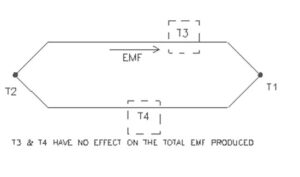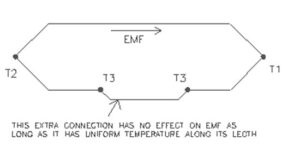- Require Consultation?
- Contact Us Now
Thermocouples are probably the most popular temperature sensors in use today. Basic models are relatively accurate, low cost, interchangeable, and can measure a wide range of temperatures. Accurate temperature measurement is one of the most common tasks faced by professionals in modern industrial and control design. This section is intended to provide an introduction to the “laws” which govern thermocouples, and the physics behind why they work.
In 1822, a discovery by Thomas J. Seebeck paved the way for the modern thermocouple. Seebeck discovered that when two dissimilar metals are connected (junctioned) together, an electric current will flow between them when one metal is heated with respect to the other. This phenomena is known as the Seebeck Effect. This current will continue to flow as long as the two junctions, known as the “hot” junction and “cold” junction, are at different temperatures. The magnitude and direction of the current is affected by the types of metals used, and the temperature difference between the hot and cold ends. There are standard tables available which show the voltage produced by a thermocouple at any given temperature for many of the more common thermocouple types. More will be covered on the actual use of thermocouples in the next section, but for now we’ll look at the reasons behind why thermocouples work the way they do.

In 1822, a discovery by Thomas J. Seebeck paved the way for the modern thermocouple. Seebeck discovered that when two dissimilar metals are connected (junctioned) together, an electric current will flow between them when one metal is heated with respect to the other. This phenomena is known as the Seebeck Effect. This current will continue to flow as long as the two junctions, known as the “hot” junction and “cold” junction, are at different temperatures. The magnitude and direction of the current is affected by the types of metals used, and the temperature difference between the hot and cold ends. There are standard tables available which show the voltage produced by a thermocouple at any given temperature for many of the more common thermocouple types. More will be covered on the actual use of thermocouples in the next section, but for now we’ll look at the reasons behind why thermocouples work the way they do.

After much investigation of thermoelectric circuits several basic concepts have been conceived. These concepts can be summed up according to 3 fundamental “laws”.
An electric current cannot be sustained in a circuit of a single homogeneous metal, however varying in section, by the application of heat alone.
What this means for thermocouples, is that if there is a temperature distribution along the wires between the hot and cold junctions, the total thermal EMF will be unaffected. Only the temperature at the junction between the two dissimilar metals will have an effect on the EMF produced.

If two dissimilar metals A and B with their junctions at T1 and T2 are joined to a third metal C at one leg, if C is kept at a uniform temperature along its entire length, the total EMF in the circuit will be unaffected.
This comes into play with thermocouples because there is usually a need to introduce extra metals into the circuit. This generally occurs when instrumentation (lead wires) is connected to measure the EMF, or when the junction is welded together on the hot end (weld rod). One would assume that the introduction of these extra undesired “junctions” would destroy the calibration and throw off the EMF measurement. However, this law states that the addition of these extra metals will not have an effect on the total EMF as long as they are kept at the same temperature as the point where they are connected.

If you have one thermocouple with it’s junction at 32°F and some reference temperature and another thermocouple at the same reference temperature and the measured temperature. This is equivalent to a single thermocouple with it’s junction at 32°F and the measured temperature.
This law is very important to thermocouples because of the fact that the cold junction of most thermocouples (in real applications) will not be used at 32°F. Unfortunately, the standardized EMF tables are usually only available with 32°F as a reference temperature. This law gives us a means of relating the EMF of a thermocouple used under ordinary conditions to that of one at a standardized temperature. This topic is covered in more detail in the section “Using your Thermocouple” under the heading “Cold Junction Compensation”.
US manufacturer with in-house capability to produce custom Mineral Insulated Cables, Thermocouple, RTDs, and Heaters.
+1 (800) 237-6725 (Toll Free)
+1 (630) 953-9100 (Phone)
381 Ari Court
Addison, Illinois 60101
Sign up our newsletter to get update information, news and free insight.